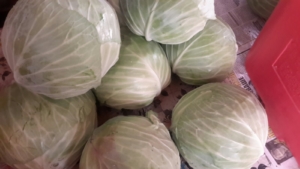Maintaining a family tradition: Bulgarian whole fermented cabbage
By Mariya Petrova, PhD, Microbiome insights and Probiotics Consultancy, Karlovo, Bulgaria

Dr. Mariya Petrova with her father
November and December mark a wonderful time of the year when the cold weather makes you want to stay at home and enjoy homemade foods and drinks. However, the heavy food during the holidays makes all of us think about healthier alternatives and how to keep our gut microbiomes in check. That’s why it can be great idea to supplement your festive menu with fermented foods.

Cabbage ready to be fermented
Partly to have healthier food options at home and partly to engage in longstanding traditions, at this time of the year, millions of people in Eastern Europe roll up their sleeves, get out their knives, salt and large containers, and make fermented vegetables at home. While Western cultures are seeing fermented foods as a trendy health food option, Eastern Europeans have never forgotten how to preserve food by using natural fermentation. In my country of Bulgaria, fermented foods are simply a part of our life. Our most popular fermented foods include whole sour cabbage, pickles and pickled vegetables, yogurt, boza (a special fermented beverage), and fermented apple cider vinegar. We do not take shortcuts by pickling our vegetables with vinegar. Ours is a traditional fermentation process – add salt and then let the natural lactic acid bacteria perform their magic.
Although all of these products are interesting and delicious, the winter season brings to my mind my father’s whole cabbage fermentation. My father is busy with it every year from the beginning of November until mid-December. Whole sour cabbage is a fermented food popular not only in Bulgaria but in many of our neighboring countries such as Serbia, Macedonia, and Romania. Although similar to sauerkraut, Bulgarian whole fermented cabbage ferments the entire cabbage head, not separate cut or shredded leaves. Using whole cabbage requires both an extended period of fermentation time (around 30 to 40 days) and extra care in handling.

Preparing for fermentation
I have pictures etched in my mind of a busy local Saturday vegetable market where people would buy between 30-50 kilograms (sometimes even more) of cabbages for fermentation – depending on the size of their families. These come to life every time I hear “fermented foods” at a conference!

Cabbage and brine
But how do you ferment such a spectacular amount of cabbage? Well, first you need some rather large barrels, of course. Then you remove the outer leaves from the cabbage, core the cabbage heads, and stick them in the barrel. This is not unlike putting together a jigsaw puzzle. The cabbage heads have to be very dense without leaving to much space between them or the fermentation will not work well. The cabbage is then covered with a brine of around 2-4% salt. Finally, something heavy is placed on top of the cabbage. Many people place a heavy rock (clean of course), to keep the cabbage heads under the salty water and to allow them to ferment properly. Packing the cabbage densely and pressing it down is done to reduce oxygen to a minimum, creating an anaerobic environment for the fermentation. For better taste some people optionally add apple, quince, horseradish, and/or beetroot (which also makes the salty water more pink).

Finished fermented cabbage
Every day the salty water has to be inverted which is achieved by flushing it from the bottom of the barrel by using connected vessels and then adding it onto the top. Day-to-day shuffling of the salty water ensures a uniform distribution of microorganisms in the barrel so that all cabbage heads ferment. The best quality fermented cabbage is produced at 12-18°C temperature for around 30 days. This is why the fermentation
is done only in November – to maintain these low temperatures. Temperature from 7.5 to 18°C favors the growth and metabolism of Leuconostoc mesenteroides, while temperatures higher than 20°C favor the growth of Lactobacillus species. At higher temperatures the fermentation process takes shorter time (around 10 days), but the quality of the fermented cabbage is lower. Leuconostoc mesenteroides is essential to start the first fermentation that produces lactic acid, acetic acid, ethyl alcohol, carbon dioxide, and mannitol. All these acids, in combination with aromatic ester alcohol, contribute to the characteristic taste of high-quality sour cabbage.
Following Leuconostoc mesenteroides fermentation, Lactobacillus plantarum takes over lactic acid production, which gives a sour taste to the fermented cabbage. At the end of this Lactobacillus fermentation the cabbage is ready to enjoy as part of traditional Bulgarian cuisine. Like a special gift left by St. Nick, many people use the salted water in which the cabbage was fermenting as a drink, rich in lactic acid bacteria, and said to help digestive health.
Acknowledgment: I thank my father for showing me how to make the fermented cabbage and taking some pictures of the process this year!

Fermented foods on the holiday dinner table





